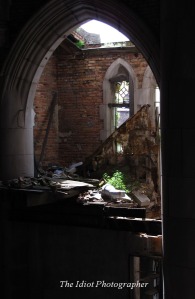The church is in decline.
Sure, I guess. But, what do you mean by that?

Membership is down in many congregations. Average weekly attendance is down, too. They are down as compared to 1965. They are down as compared to 1985. They are down, in many places, as compared even to 2005. There has been a general decline in the church.
And it’s not just people. There’s not enough money. Ministries – campus ministries, urban ministries, youth ministries – are being closed down or cut back due to lack of funding. And the buildings. They are crumbling. Literally, crumbling.
The church is in decline.
Sure, I guess. But, what do you mean by that?
[Confused that I asked the question again]
No, not what do you mean by decline. You already covered that. This time I’m asking about what you mean by church. What is this “church” that is in decline?
The church on the corner. It has beautiful stained glass windows, dark wood pews, and a fellowship hall. Two worship services. Sunday school classes and Vacation Bible School. A seniors group and, sometimes, a youth group. It’s a place where people come to learn and grow and be together and worship and serve. That’s the church that’s in decline.
OK. Glad we got that cleared up. The institution that we’ve come to know and love, the institution that we have called “church” all these years, is in decline. Yes. But, I’m unwilling to say that “the church” is in decline. You see, it all depends on what you mean by “church.”
church n a big building on a corner lot with one (or more) full-time pastor(s) and other staff members, where people of a common faith gather for weekly worship and Bible study, a variety of fellowship, program, and service ministries, youth programs, education, etc.
church n the assembly of saints in which the gospel is taught purely and the sacraments are administered rightly.
Increasingly we are unable to sustain the first definition of church. That first definition represents a model of being church that was born in an era that has come and gone, an era in which church was seen as a prestigious community institution to stand alongside government and civic institutions. It is a way to do church that thrived on historically high rates of church participation, a culture that embraced (certain forms of) religion, and a post-war economic boom. It is a way to do church that was funded by an unusually high volume of offerings given faithfully by the unusually high numbers of people who attended church. Lots of good and faithful ministry happened in this model of being the church, but it is a model that does not thrive in today’s cultural and economic climate as much as it did in the past.
Today, church participation rates are leveling out in relation to historical trends. Today, the church does not have as vaunted a privileged place in society as it once did. Today, household discretionary income is at historic lows, debt levels are skyrocketing, and good paying jobs for young and middle aged people are harder to find. Today’s culture and economy simply do not support the model of church that thrived in the mid 20th century.
Too often when we speak of “church decline” we speak of the inability to maintain the buildings and staffing and programming of the 20th century church. We speak of an inability to pay the bills. Fair enough. But buildings and staffing and programming (and money to fund these) are not the church. A lack of funds represents a decline in how we do church, but not in church itself.
People, gathering at the foot of the cross and the opening to the empty grave to give God their praise and receive God’s many blessings – that is church. Or, to  use traditionally Lutheran lingo, the church is “the assembly of saints in which the gospel is taught purely and the sacraments are administered rightly” (the second definition, above, from the Augsburg Confession VII). Or, to quote Professors Wengert and Lathrop, “Church is not a noun; it is a verb, an event, or, to use the language of the sixties, a happening” (Christian Assembly: Marks of the Church in a Pluralistic Age, pg 27). Church is that encounter with God’s Word that puts sin to death and gives rise to a new creation. Such an understanding of church doesn’t require dedicated buildings, staff, or programs.
use traditionally Lutheran lingo, the church is “the assembly of saints in which the gospel is taught purely and the sacraments are administered rightly” (the second definition, above, from the Augsburg Confession VII). Or, to quote Professors Wengert and Lathrop, “Church is not a noun; it is a verb, an event, or, to use the language of the sixties, a happening” (Christian Assembly: Marks of the Church in a Pluralistic Age, pg 27). Church is that encounter with God’s Word that puts sin to death and gives rise to a new creation. Such an understanding of church doesn’t require dedicated buildings, staff, or programs.
In some places the received model of church – building, program ministries, staff – is working well. Thanks be to God! Let us pray for the church to thrive in such a way! Yet in a growing number of communities this model of being the church is struggling.
Many of our attempts to renew the church today are aimed at renewing the 20th century model of church, at renewing the received model 0f church supported by a building, pastor, and programs. I hope and pray that such renewal efforts bear fruit, and indeed it seems that some such efforts are bearing fruit. Praise be to God!
Nonetheless, I think we need the creative and faithful imagination to conceive of, and the courage to be, church in drastically new ways, as well. Alongside familiar and renewed models of church, let us also live into new ways of being the church. Such new ways might look like extremely old ways (see Acts and the early church), ways that may have fewer of the trappings of the (beloved) institutional church. Such new/old ways of being church might have a different kind of intimacy, meeting in living rooms and coffee shops rather than in grand sanctuaries. Such new/old ways of being church may have less reliance on professional clergy and more reliance on the shared wisdom and faith of the community. Such new/old ways of being church might find an essential connectivity in social media, just as Saint Paul used social media (letters that were passed around among early Christians) to connect with and encourage the earliest Gentile churches.
Particularly in those areas where the received model of being the church is not thriving, but also alongside established congregations, such new/old ways of being church can renew our experience of a Christian community that gathers at the foot of the cross and the opening to the empty grave. Such new/old ways of being church can faithfully gather God’s people around Word and Sacrament and be that community of sinners redeemed and saints sent into the world to love and serve.
The church church is not in decline as much as the way we do church is in decline. Let us nurture established congregations into ever more faithfulness and vitality, and let us also give birth to new/old communities that live into the promises of God in new ways for this new day.

You bring up a point many people forget. The Church (capitol ‘c’) is made up of believers whereas the church on the corner is made up of bricks. It’s a shame to see some of the beautiful old buildings not be maintained but I’d rather see those buildings fall and the universal Church stand!
Speaking of the “church in decline” in this manner also focuses on one thing only–numbers. What a terrible way to talk about the church! I would rather have 10 people living out God’s mission in the world than a building claiming 900 “members” that refuses to give aid to the needy.
The problem is that when you try to “do church” without buildings, staff, music, art, rituals, classes, etc, it is simply preaching to the choir — no one outside the small group of insiders recognizes it as “church”. If we wish to “preach the gospel purely” we need a willing audience to preach to (and we need to understand ourselves what “preaching the gospel purely” even means). If we want to administer the sacraments rightly, we need people to understand what the sacraments are and why they should care.
Many of the churches that are currently “thriving” with buildings and staff and programs and whatnot are not — by many people’s understanding — “preaching the gospel purely” or “administering the sacrament rightly”, so what’s the point?
I suppose my point is that before we even begin to talk about new way of doing church, we need to establish what we are doing church for. What does “preaching the gospel purely” and “administering the sacraments rightly” actually mean? And we have to do so in plain language that means something to people who are not already “church insiders”.
Perhaps if we clarified for ourselves and other what preaching the gospel means in the 21st century, and how the sacraments are relevant, the issue of declining participation would go away on its own?
Church is boring. I’m glad I don’t waste time, money and effort on it.
Mainline Protestantism is pretty much Something White People Like.